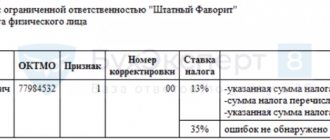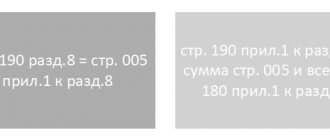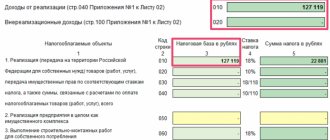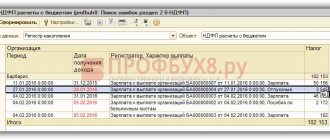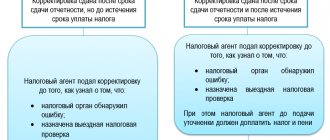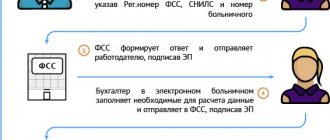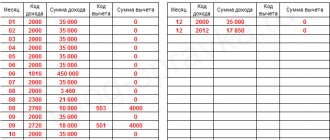Personal income tax is a tax that citizens of the Russian Federation pay to the treasury on the income they receive. Employers are required to transfer personal income tax for employees centrally to the budget in the form of taxes from the enterprise. The legislation has approved two forms by which organizations generate reports on employee income, which also includes information on deductions and accrued taxes. Until 2021, the only report on the income of individuals submitted to the tax office from an enterprise was a certificate in form 2-NDFL. The deduction and income codes changed, but only the principle of generating the certificate remained unchanged: individual information for each employee of the company. Now there are two such forms: 2-NDFL has been supplemented by calculation using form 6-NDFL. These reports are submitted to the inspectorate simultaneously - at the end of each quarter. The difference between 6-NDFL is the consolidation in one document of information relating to personal income tax for individuals who have received any payment from the company in the form of salaries, dividends and payments under other contracts.
How the tax office checks the report
When a completed report is received from an enterprise, the tax office checks it for compliance with the control indicators. The legislation provides for a procedure for checking reports, identifying inconsistencies and an algorithm for issuing requirements and applying penalties. Taxpayers have access to all information on the taxpayer, all reports are consolidated in the taxpayer’s card. Therefore, an organization should take care of such a procedure as checking 2-NDFL before submitting a tax and income tax return, since then it will not be possible to “adjust” the information. Inspectors check received reports for two types of deficiencies:
- Errors inside the report are errors associated with incorrectly specified values in the columns of the report, that is, the relationship between the lines is not satisfied (such errors are found by special accounting programs).
- Lack of necessary relationships between values in three documents: 2-NDFL, 6-NDFL and income tax return (such errors can only be detected manually).
If errors are identified, the inspector requests an explanation of the information from the accountant. If a response to the request is not sent, the tax office may order an audit. During the audit, the organization will be required to provide originals of all documentation used to complete the report to confirm the accuracy of the information. To relieve all accounting personnel from such worries, it is recommended to independently take actions such as checking 6-NDFL, and if an error is discovered by the organization, immediately provide clarification. When filling out, you need to focus on typical errors, including typos, since a typo is considered as unreliable information, even when it is obvious as a technical error.
Monitoring indicators 6-NDFL and Appendix 2 to the DNP
The Federal Tax Service's letter also regulates the compliance of indicators 6-NDFL and Appendix 2 to the income tax return (DNP):
- p. 020 6-personal income tax at the same rate must correspond to the amount of p. 020 appendix 2 to the personal income tax with the same rate;
- p. 025 6-NDFL is equal to the amount of income under the same code in Appendix 2 of the DNP;
- tax amounts at the same rate on line 040 in 6-NDFL = amount on line 030 of Appendix 2 to the DNP;
- the indicators for the amount of unwithheld tax should be equal: page 080 of form 6-NDFL and page 034 of appendix 2 to the DNP;
- The number of individuals according to page 060 6-NDFL must also coincide with the number of attachments 2 (for each person who received income in the form of dividends, a separate application sheet is filled out).
Companies dealing with securities and paying dividends are required to fill out Appendix 2 to the DNP for the reporting year.
Reporting when calculating dividends
How to check form 6-NDFL before submitting it to the tax office
Before sending 6-NDFL to the inspector, you should check it for compliance with the form of the report form and the electronic format, as well as for the correctness of completion and accuracy of the indicated indicators in the sections of the report. The control ratios developed and established by law, which were developed by the tax authorities themselves, will help to verify the correctness of the calculations. These indicators will help you detect inconsistencies in the form of simple typos and analyze whether the report has been compiled correctly. The first section of 6-NDFL contains all the information on the enterprise on a cumulative basis for all previous quarters from the beginning of the year, including the current one, and the second section contains information only for the current quarter. The sections perform different functions, so they do not correspond with each other. Therefore, to the assumption: should the amount of accrued income from section 1 of the 6-NDFL report go with the total amount from section 2, the answer is negative. No control relationships between sections can be established.
Control ratios 6-NDFL and RSV
6-NDFL and DAM reports :
It may not be fulfilled if the organization pays income not subject to personal income tax.
For example, in line 020 6-NDFL report, will not be reflected, but in line 030 of Appendix 1 of the report on insurance premiums:
- child care allowance up to 1.5 years;
- maternity benefits;
- sick leave accrued in December 2021, but paid in January 2021.
To find the differences between 6-NDFL and RSV, see our life hack - How to find the difference between the amounts in 6-NDFL and RSV
Those. These control ratios may indeed not be met and this is normal. However, in this case, the Federal Tax Service will have to provide explanations about the reasons for their non-compliance.
See - An example of a response to the requirements of the Federal Tax Service to provide explanations for discrepancies in the 6-NDFL and Calculation of insurance premiums reports
Checking the title page
To begin with, it is recommended to perform such a simple operation as checking that 6-NDFL is filled out correctly on the title page, then we check both parts of the report. The first sheet contains basic information about the company (name with explanation, codes, address, telephone, etc.); information about the inspection where the enterprise is registered. A separate report is generated and submitted for each branch of the enterprise, where the codes of the corresponding enterprise are indicated; a personal report is provided for the parent company. In accordance with the new changes made to the rules for filling out the title page of personal income tax-6, two lines have been allocated specifically for assignees and three codes have been added for the place of submission of the report. For the initial version of the report, the adjustment code is indicated as 000, and for adjustments - from 1 and successively further, for example, 003. Some employers mistakenly assign code 001 to the initial report.
Checking the first section
The first section should indicate the totals for all previous tax periods for all individuals to whom the company paid money. If an enterprise paid income taxed at different rates for the past reporting period, it will be required to provide the completed first part of the report for each rate on a separate sheet. If personal income tax was calculated at the rates: 13, 15, 30, 35%, then in lines 10 to 50 the manager or accountant of the enterprise enters information in each section number 1, and lines from 60 to 90 - only on page 1 of this first section. If all payments were made based on the tax rate, for example, 13%, then the organization draws up one first section, filling out all lines from 10 to 90.
Checking the second section
The design of the second section is more difficult than the first. It is very important not to make mistakes with dates and amounts. The second section consists of identical blocks for placing information on dates and amounts with lines from 100 to 140. To reliably fill out the second section, you must indicate the dates correctly. To accurately enter information, you need to prepare documentation, from which you can highlight:
- Date of actual receipt of income. This date is not the date when money is issued to an individual. This refers to the date of accrual of income (for salary, for example, this is the last day of the month).
- The date of personal income tax withholding from this income. This is the number of tax withholding from income, and not the number of the payment order for the transfer of tax.
- The last day of the period when the organization was obliged to transfer the personal income tax withheld from this income to the budget.
If these three numbers are the same, then the accountant groups the information and indicates it in one block of lines from 100 to 140. If the dates differ, the blocks are filled out individually for each date, and the number of blocks corresponds to the number of date options.
Connecting control ratios
You can carry out such work as checking whether the calculation of 6-NDFL is correct using control ratios. Control ratios are a sequence of mathematical calculations between certain lines that must coincide with other report indicators, that is, all calculations encrypted in the report lines must, when crossed, give the corresponding results. The organization is not obliged to check the control ratios of 6-NDFL (for the 3rd quarter of 2021, by the way, they will probably differ compared to the 1st quarter of the same year). This procedure is advisory in nature to eliminate elementary errors in the report made by the accountant. Some new accounting programs already include an option such as “check form 6-NDFL”, that is, automatic verification of information entered in the lines of the report for compliance with control ratios. As a result of the analysis, the program offers options for adjusting the data. However, it is recommended to take such a step as checking 6-NDFL yourself, recalculating several or all control ratios manually on a calculator - this will protect the accountant from making adjustments. The letter from the tax service contains twelve points of those indicators, the discrepancy of which will cause additional clarifications from the tax authorities. Here are some of them:
- the actual date of filing 6-NDFL coincides with the date indicated on the title page of the report;
- the calculated value of total income indicated in line 20 must be no less than the value of total deductions on line 30;
- the value of line 40 must correspond to the result of the following operations: the difference between lines 20 and 30 *line 10/100;
- the value from line 40 must be no less than the value from line 50;
- the total amount contributed to the budget must be no less than the delta between the amount of personal income tax actually withheld (line 70) and the value of line 90 (refund to the payer) of the tax.
Returning to the question of how to check 6-NDFL, we will give an example of changes in control ratios. In previous editions of the letters, it was recommended to use 6-NDFL as a control ratio for checking: line 070 should be equal to the sum of lines 140. Let us recall that in line 70 the enterprise informs how much it withheld personal income tax, in line 140 - the same tax with distribution by dates of payment of all types of remuneration. Then the tax authorities changed their minds and admit that this control ratio is not always valid. An exception to the previously proposed ratio was the transfer of actual payments in the quarter following the accrual, for example, of wages. Therefore, some amounts do not fall into line 140 in the second part of the report. There is no violation of the law in this case: one quarter ends, the report is closed, and salaries are paid in the next quarter. Hence the discrepancy in the results according to the verification formula previously proposed by the tax authorities. Based on the assumption that some organizations calculate and pay salaries according to this scheme, the Federal Tax Service excluded this control ratio from the list of mandatory ones. The department confirmed on its official website that this ratio is not mandatory. Therefore, in order to perform such an operation as checking 6-NDFL for 2021 (for any reporting period of this year), there is no need to apply this control ratio. If the accountant nevertheless decides to conduct a more pedantic study of the report being prepared for submission, we remind you that the difference in the values of the highlighted lines is the amount of the actual payment of remuneration on which tax was accrued in the current reporting period, and the payment will be made in the next quarter.
Features of generating the 6-NDFL report
The process of creating Form 6-NDFL differs from other personal income tax reporting by the following:
- it is done quarterly, compiling a cumulative total for the period from the beginning of the year and forming separately for all separate divisions;
- it contains summary (generalized) data relating to all employees of the department as a whole;
- it becomes common for her to have amounts carried over to another reporting period, which is associated both with the payment of wages at the end of the month for which it is accrued, and with the transition to another month of the tax payment due date due to a gap in the dates of withholding and payment and from - for the possibility of postponing the payment date if it falls on a weekend;
- its data can be compared with information included in other reporting on the income of individuals and other documents prepared through the tax authorities.
The Federal Tax Service will check the correctness of the numbers and dates included in 6-NDFL for the first 3 points only during an on-site inspection. However, the report compiler needs to create an internal control system that allows you to systematically monitor the correctness of the figures entered into the reporting and promptly correct data incorrectly reflected in 6-NDFL. Failure to comply with this will lead not only to additional tax payment and punishment in the form of penalties and fines, but also to sanctions for submitting false information (clause 1 of Article 126.1 of the Tax Code of the Russian Federation).
Current reports submitted to the tax authorities will necessarily be checked by the Federal Tax Service Inspectorate logically, and the data of the annual report will be additionally verified with the information submitted in the 2-NDFL certificates and in the profit declaration.
With regard to the rules for logical verification of current 6-NDFL reports and comparison of reporting with data from other sources, the Federal Tax Service has developed a document containing the ratios necessary for control that will guide the tax authorities when checking 6-NDFL (letter of the Federal Tax Service of Russia dated March 10, 2016 No. BS-4- 11/ [email protected] ). All control ratios (hereinafter referred to as CS) contained in it are divided into 4 groups, numbered, provided with comments on possible violations associated with them, and instructions on the actions of inspectors regarding a possible or identified violation. These actions include:
- request for clarification on the identified contradiction;
- drawing up a violation report if the explanations do not satisfy the inspectors.
ATTENTION! In October 2021, tax authorities issued an additional letter dated October 17, 2021 No. BS-4-11/ [email protected] , according to which new control ratios should be applied when inter-document control of indicators 6-NDFL and 2-NDFL. You can download the new control ratios here.
For compilers of Form 6-NDFL, these ratios are of undoubted interest, since they allow them to independently check the consistency of the data submitted to the Federal Tax Service and link the information specified in it with the information available in other reports and documents.
We compare 6-NDFL for the year with 2-NDFL and profit declaration
We looked at how to check 6-personal income tax for 9 months, 3 and 6 months using the example of using control ratios along the lines of two parts inside the report. Here's how to check the 6-NDFL report for the year - it is recommended to use additional tools. As a result of checking, the values of some lines of the 6-NDFL annual report must definitely correlate with the information provided by the organization in the 2-NDFL certificate and profit declaration for the same period. Tax inspectors use the following control ratios to check the submitted report:
- the value of line 20 (total accrued income) is equal to the amount according to the declared 2-NDFL certificates and the amount in line 20 of the second appendix in the profit declaration;
- the value of line 25 (total dividends accrued) must be equal to the amount according to the declared 2-NDFL certificates and according to code 1010 correspond to Appendix 2 of the declaration;
- line 40 (calculated tax) coincides in value with line 30 of the second appendix of the declaration and with the amount of calculated tax according to the declared 2-NDFL certificates;
- the withheld tax in line 80 corresponds to line 34 of the declaration in Appendix 2 of the declaration and the amount of unwithheld tax according to the declared 2-NDFL certificates;
- the number of individuals who received payments from the enterprise is equal to the number of 2-NDFL certificates and the number of annexes No. 2 prepared for the declaration.
Checking “mathematics” in 2-NDFL
You can check the “mathematics” (compliance of the calculated tax with the tax base, etc.) in 2-NDFL using the Legal Entity Taxpayer program.
You can download the Legal Entity Taxpayer program on the nalog.ru website using the link →
When you start working with the program, you will need to fill out information about the organization, then download the file with 2-NDFL certificates from the 1C program and upload it to Taxpayer Legal Entity.
After launching the check, its results in the Taxpayer Legal Entity can be displayed in the following form:
The most valuable thing about the program is that it tests “mathematics”. For example, it compares:
- the amount of personal income tax calculated in the 2-NDFL with the calculated personal income tax calculated;
- the amount of personal income tax transferred and withheld (personal income tax transferred should not exceed the withheld tax);
- the amount of personal income tax withheld with the estimated personal income tax withheld.
Fines
The deadlines for submitting the 6-NDFL report are established by law, and it is not recommended to violate them, otherwise, penalties will be imposed on the company. For failure to submit reports, in addition to a fine of 1,000 rubles for each month of delay, the organization faces the possibility that the company's current account will be completely blocked and unblocked only after the report is submitted. It seems possible to avoid penalties if the organization independently corrects errors and submits clarifications before the inspector identifies the inaccuracies. For submitting a report containing errors, the organization will be fined, and the tax office will require clarification.

